-
Engine3.4L Boxer Six
-
Power350 HP / 287 LB-FT
-
TransmissionPDK Dual-Clutch
-
0-60 Time4.4 Seconds
-
Top Speed177 MPH
-
DrivetrainRear-Wheel Drive
-
Curb Weight3,234 LBS
-
Seating2
-
MPGNA
A Soft Top Worthy Of The Best 911 Ever
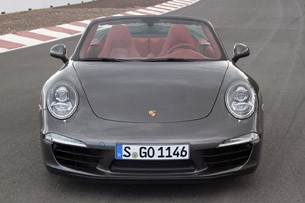
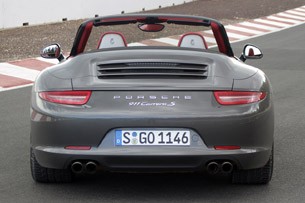
... even though you might not think so at first. Nearly all of the formal presentation we were privy to was devoted to the roof, and almost all of what was left over was devoted to the 12-speaker, 800-watt Burmester stereo. Porsche has been doing what it does with the 911 for so long that no one really expected this particular convertible to go rogue. Still, engineers wanted to make sure we understood that they hadn't just designed a roof, but that they'd figured out how to wrap folding-hardtop convenience inside fabric soft-top simplicity.
The result is called the Panel Bow roof, and of course, it isn't exactly simple. An aluminum crescent sits beneath the rear deck and the roof mechanism is controlled by two outboard aluminum arms. The 991 droptop uses roughly the same quantity of aluminum as the 997 cabrio's, but the 991 uses a great deal more die-cast magnesium and a great deal less steel. The aluminum arms are attached to magnesium brackets in the body, and the panels between the roof bows are also the light stuff. That is how the more-substantial 991 roof is able to match the 36-kilogram weight of the 997's lid.
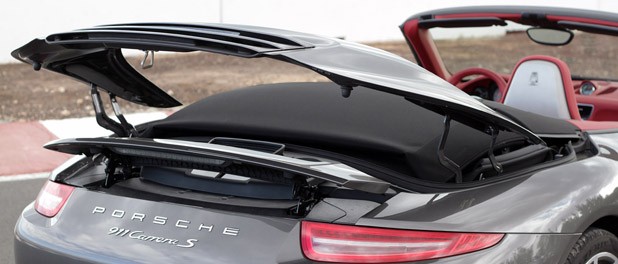
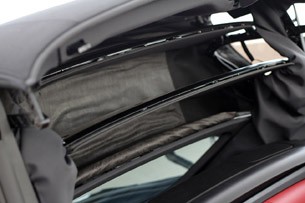
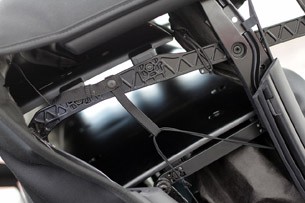
There are two additional panels in the new convertible behind the solid forward section (which was also in the 997) and ahead of the rear window. When the roof is lowered, the panels stack on top of the rear window – which now has its own frame and actuating motor – and underneath the forward section, which is the visible portion of the stowed roof between the tonneau cover and the rear seats. The 230-millimeter stack height remains the same as on the previous car, but because the shoulder line of the 991 has risen to accommodate the Carrera S's standard 20-inch wheels, it appears thinner.
When you run your hand from the windscreen all the way back to the engine cover, all you feel is solid metallic substantiality. Look at any video of the previous car's roof in action and the difference is immediately visible – the fabric doesn't bunch between the bows. The only soft-yet-still-taut spot on the new car remains in the C-pillars. The whole shebang drops in 13 seconds and up to 50 kilometers per hour. Another link it has with the hardtop is that on the coupe, when the sunroof is opened, the rear spoiler angle increases in order to maintain its position in the airstream; the rear spoiler does the same on the Cabriolet.
In seven years of planning, Porsche's roof engineers didn't only find a way to make a better, lighter top, they found a way to pay a smaller price when it came to marrying the roof to the car. The weight of the 997 Carrera convertible equipped with with the 3.6-liter flat-six and PDK dual-clutch gearbox was 1,530 kilograms (3,366 pounds). Porsche got the curb weight of a PDK-equipped 991 convertible (with its 350-horsepower, 287 pound-feet of torque 3.4-liter engine) down to 1,463 kg (3,219 lbs), which they deemed "as light we could go." Then they added seven kilograms, all of 15.4 pounds, for extra stiffening and the electric motor that controls the rear window, making its final weight 1,470 kg (3,234 lbs).
High-strength steel is used in the A-pillar and B-pillar for door-sill reinforcement, and there's a rectangle of the carbon-enhanced iron traversing the car. Yet the item mainly responsible for the meager weight gain is said to be the new rollover mechanism. The previous car had roll hoops attached to an aluminum subframe, whereas the 991's mechanism is a self-supporting, load-bearing component of aluminum and high-strength steel – it's part of the car instead of attached to the car. The hoops themselves reside beneath two panels behind the rear headrests, and are topped by carbide points that break the rear window if the roof is up; that way they can extend all the way in order to support the car's weight.
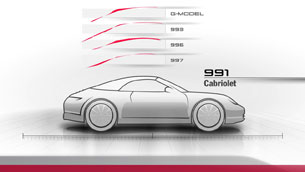
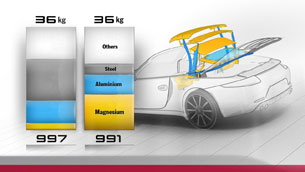
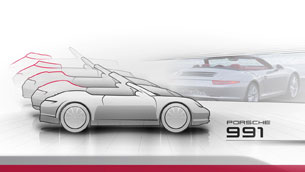
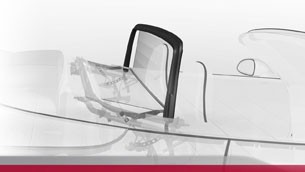
Instead of going the extra mile, the guys in white lab coats went the extra half-marathon to achieve the same silhouette as the coupe with the top up – something we had no idea they cared so much about. We were shown a series of slides outlining the differences between coupe and cabrio profiles going back to the first 911 'vert, the 1982 911 SC. On the overlays, slivers of crimson were the difference, the errant slash of a medium-tipped red pen. After three decades, though, their collective aesthetic nightmare has come to an end. We weren't able to test it (there were no coupes on the island), but were told that if you line up a coupe and a cabriolet, from the side you will divine nary a difference.
In case we haven't made the point enough, you don't get here by accident.
Gran Canaria's roads are alternately much better than you'd ever expect for a lump of basalt in the middle of the Atlantic, and just what you'd expect for a lump of basalt in the middle of the Atlantic. Nevertheless, there are more compelling distractions that will keep your driving in check: cliff-face switchbacks that are San Francisco's Lombard Street meets The Land Before Time, thousand-foot drops over diminutive rock barriers and guardrails, and someone's idea that the equation for the proper road width should be "Just enough for two tiny cars – and I mean just enough – then minus half a car width." That was why when you got a stretch of clear road you ran it like Bullitt, because it could be a long way behind a Renault Twingo before you got another one.
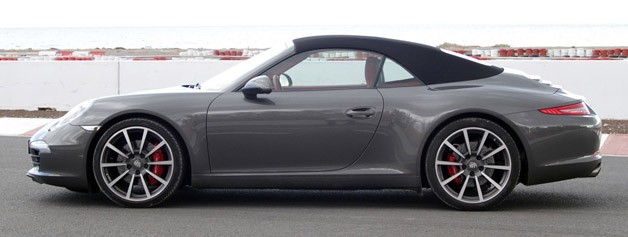
The upside was that we got a chance to see just about all sides of the new 911 Cabriolet – aided by a dozen hot laps around an ocean-side track.
If there was one topic we discussed as much as the top, it was the steering, gossiped about like oenophiles discussing an early vintage Veuve-Clicquot: "I heard it was no good," "Well so-and-so hated it," "He would, wouldn't he?", "Well, I heard it was tuned by aliens with three hands."
We found it as precise as it's always been, but with recognizably less feedback. The last-gen 997 not only informed you of minute changes in road surface, you could tell where the stone had been quarried and which model of Mitsubishi road grader had been used. If you were unfortunate enough to be involved in a roadkill you could identify the contents of the squirrel's last meal down to the nut. We've read that the change had to do with owners complaining about nervousness in the 997 at upper-tier Autobahn speeds. That might have played a part, but Porsche's own explanation made more sense: EPA regulations forced its hand – when you can get one extra mile per gallon by going electric, you've got to take it.
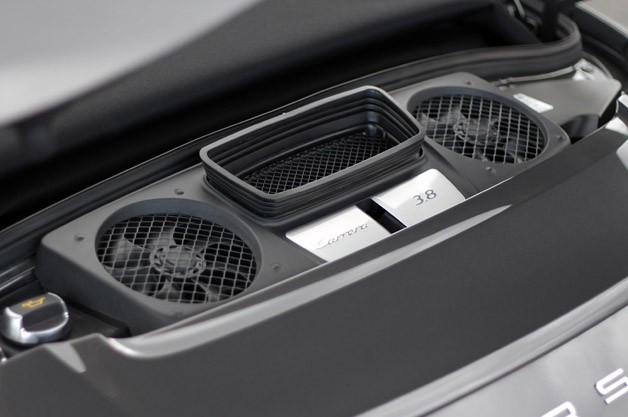
And let's not minimize it, there's a difference between nine-tenths and ten-tenths. But would the Israelites have complained if Moses came down the mountain with just nine commandments? Of course not. That last tenth was probably wasted on a fair number of Porsche's buyers anyway (not on us, mind you). Rumor is that it made others nervous, but we're still in rare air when we talk about Porsche steering – it's like going from Everest's 29,029 feet to K2's 28,251. The steering is plenty good, and unless you've been to Everest, you won't even know how to begin complaining.
When we could give it the boot on good roads, the wheels could be put where we wished, and excess enthusiasm was scrubbed off with the ever-capable six-piston front brakes on steel rotors, or with understeer-killing applications like torque vectoring. The 997 was tidily stiff, and the 991 ups the twist resistance by 18 percent from 9,000 Newton-meters/degree to 11,700. So when the roads got as unbearable as Medusa, you could not only detect the convertible's adaptive suspension dealing with the road, but also working to tame a chassis so stiff that it might be inclined to skip right over the broken surface because it refused to flex at all. It's a very coupe-like experience. Which is the point.
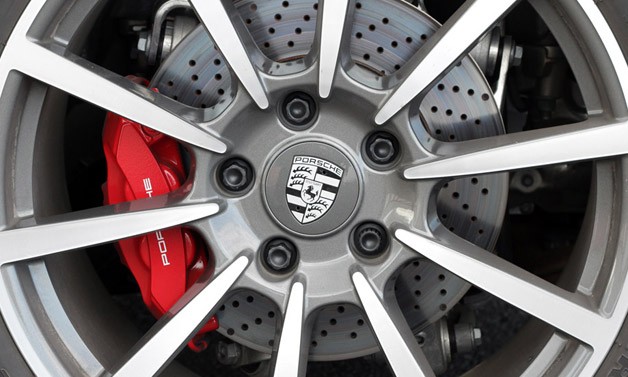
With a completely new model, one-to-one comparisons are sketchy when making attributions for interior noise; the 991 coupe is quieter than the 997 coupe, and the convertible doesn't alter the formula. Engineers were shooting for a roughly two decibel drop in interior noise with the top up, and they achieved it – but the entire package is much quieter. Forget about the steering, just sitting in the cabin at speed is when we were inclined to ask, "Is this really a Porsche? It's so... demure." Casual conversation was welcome with the top up or down, which means we now live in a world where Mercedes-Benz makes an everyday-driver convertible, the SLS AMG Roadster, that's louder, lairier and less comfortable to converse in than any Porsche convertible.
Is it a softer 911 overall? Certainly. Is it still good enough to be a 911 (cue the angels) in spite of it? Certainly. You don't feel the goodness as much, and that leads some to ask "Then how can it be as good?" Because with more power, more speed, more room, better handling, better gas mileage, and more convenience, you can do even more with it. And remember we're talking relative comparisons here – it's not that soft...
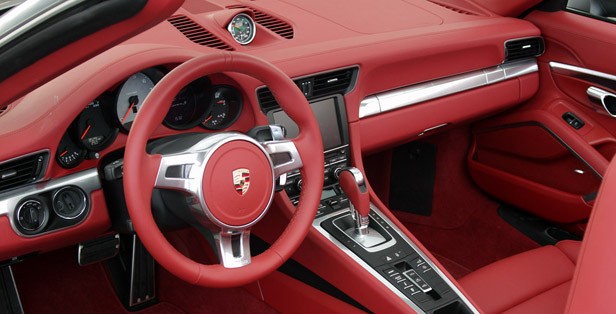
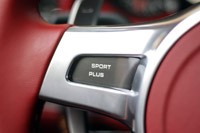
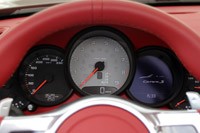
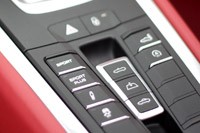
Get it on the track and the infinitesimal gap in dynamics between the cabrio and genuine coupe sensations was even more apparent – and frankly, even with the "loud button," the track is what it took to rouse the car from its demure mien. The Porsche Dynamic Chassis Control system, by counteracting dive, will help you overcook your entry speeds to an extent that even torque vectoring can't cure, with sudden understeer and a looming gravel trap prodding you to find some new visceral way to keep track of your velocity. The carbon brakes, with larger rotors on the Carrera S, are absurdly competent. Lapping the rather tight loop, at not one time did we think, "This is excellent for a convertible." We just realized, "This is excellent."
We also tried out the Porsche Entry & Drive system, which allows you to hold your hand over the front bumper to open the trunk. In other markets, but supposedly not America, E&D will also let you open and close the top using a button on the keyfob. Something about U.S. litigation being a little too eager means no such convenience for us, though. About the only other thing you won't get on the topless 911 besides a steel roof is the -20 Porsche Active Stability Management package that lowers the car by 20 millimeters. Not an option.
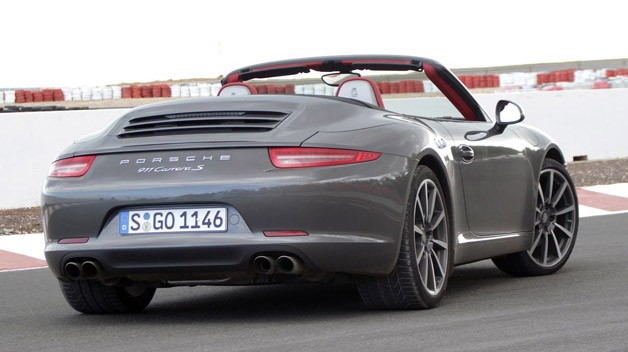
In every other way, though, Porsche has delivered with its new convertible the same advanced experience that critics have been singing about regarding the coupe. It isn't like they had to. Based on the 911 Cabriolet demographic, instead of flying us to all the way to Gran Canaria, Porsche could have held the launch in Monaco, with a drive route from the Casino to Marina, where we'd celebrate our 1.2-mile jaunt partying on a superyacht with slick-haired, Ray Ban-wearing waiters and Junoesque, zaftig women with strange accents and impossibly high heels at the ends of impossibly long legs.
But we're glad Porsche didn't do that, and instead gave its all to shrinking the already-small compromises one makes for choosing the open air. The new 911 coupe has redefined what that car is. The convertible didn't just remove the roof, it has rewritten a few definitions of its own.


... even though you might not think so at first. Nearly all of the formal presentation we were privy to was devoted to the roof, and almost all of what was left over was devoted to the 12-speaker, 800-watt Burmester stereo. Porsche has been doing what it does with the 911 for so long that no one really expected this particular convertible to go rogue. Still, engineers wanted to make sure we understood that they hadn't just designed a roof, but that they'd figured out how to wrap folding-hardtop convenience inside fabric soft-top simplicity.
The result is called the Panel Bow roof, and of course, it isn't exactly simple. An aluminum crescent sits beneath the rear deck and the roof mechanism is controlled by two outboard aluminum arms. The 991 droptop uses roughly the same quantity of aluminum as the 997 cabrio's, but the 991 uses a great deal more die-cast magnesium and a great deal less steel. The aluminum arms are attached to magnesium brackets in the body, and the panels between the roof bows are also the light stuff. That is how the more-substantial 991 roof is able to match the 36-kilogram weight of the 997's lid.



There are two additional panels in the new convertible behind the solid forward section (which was also in the 997) and ahead of the rear window. When the roof is lowered, the panels stack on top of the rear window – which now has its own frame and actuating motor – and underneath the forward section, which is the visible portion of the stowed roof between the tonneau cover and the rear seats. The 230-millimeter stack height remains the same as on the previous car, but because the shoulder line of the 991 has risen to accommodate the Carrera S's standard 20-inch wheels, it appears thinner.
When you run your hand from the windscreen all the way back to the engine cover, all you feel is solid metallic substantiality. Look at any video of the previous car's roof in action and the difference is immediately visible – the fabric doesn't bunch between the bows. The only soft-yet-still-taut spot on the new car remains in the C-pillars. The whole shebang drops in 13 seconds and up to 50 kilometers per hour. Another link it has with the hardtop is that on the coupe, when the sunroof is opened, the rear spoiler angle increases in order to maintain its position in the airstream; the rear spoiler does the same on the Cabriolet.
In seven years of planning, Porsche's roof engineers didn't only find a way to make a better, lighter top, they found a way to pay a smaller price when it came to marrying the roof to the car. The weight of the 997 Carrera convertible equipped with with the 3.6-liter flat-six and PDK dual-clutch gearbox was 1,530 kilograms (3,366 pounds). Porsche got the curb weight of a PDK-equipped 991 convertible (with its 350-horsepower, 287 pound-feet of torque 3.4-liter engine) down to 1,463 kg (3,219 lbs), which they deemed "as light we could go." Then they added seven kilograms, all of 15.4 pounds, for extra stiffening and the electric motor that controls the rear window, making its final weight 1,470 kg (3,234 lbs).
High-strength steel is used in the A-pillar and B-pillar for door-sill reinforcement, and there's a rectangle of the carbon-enhanced iron traversing the car. Yet the item mainly responsible for the meager weight gain is said to be the new rollover mechanism. The previous car had roll hoops attached to an aluminum subframe, whereas the 991's mechanism is a self-supporting, load-bearing component of aluminum and high-strength steel – it's part of the car instead of attached to the car. The hoops themselves reside beneath two panels behind the rear headrests, and are topped by carbide points that break the rear window if the roof is up; that way they can extend all the way in order to support the car's weight.




Instead of going the extra mile, the guys in white lab coats went the extra half-marathon to achieve the same silhouette as the coupe with the top up – something we had no idea they cared so much about. We were shown a series of slides outlining the differences between coupe and cabrio profiles going back to the first 911 'vert, the 1982 911 SC. On the overlays, slivers of crimson were the difference, the errant slash of a medium-tipped red pen. After three decades, though, their collective aesthetic nightmare has come to an end. We weren't able to test it (there were no coupes on the island), but were told that if you line up a coupe and a cabriolet, from the side you will divine nary a difference.
In case we haven't made the point enough, you don't get here by accident.
Gran Canaria's roads are alternately much better than you'd ever expect for a lump of basalt in the middle of the Atlantic, and just what you'd expect for a lump of basalt in the middle of the Atlantic. Nevertheless, there are more compelling distractions that will keep your driving in check: cliff-face switchbacks that are San Francisco's Lombard Street meets The Land Before Time, thousand-foot drops over diminutive rock barriers and guardrails, and someone's idea that the equation for the proper road width should be "Just enough for two tiny cars – and I mean just enough – then minus half a car width." That was why when you got a stretch of clear road you ran it like Bullitt, because it could be a long way behind a Renault Twingo before you got another one.

The upside was that we got a chance to see just about all sides of the new 911 Cabriolet – aided by a dozen hot laps around an ocean-side track.
If there was one topic we discussed as much as the top, it was the steering, gossiped about like oenophiles discussing an early vintage Veuve-Clicquot: "I heard it was no good," "Well so-and-so hated it," "He would, wouldn't he?", "Well, I heard it was tuned by aliens with three hands."
We found it as precise as it's always been, but with recognizably less feedback. The last-gen 997 not only informed you of minute changes in road surface, you could tell where the stone had been quarried and which model of Mitsubishi road grader had been used. If you were unfortunate enough to be involved in a roadkill you could identify the contents of the squirrel's last meal down to the nut. We've read that the change had to do with owners complaining about nervousness in the 997 at upper-tier Autobahn speeds. That might have played a part, but Porsche's own explanation made more sense: EPA regulations forced its hand – when you can get one extra mile per gallon by going electric, you've got to take it.

And let's not minimize it, there's a difference between nine-tenths and ten-tenths. But would the Israelites have complained if Moses came down the mountain with just nine commandments? Of course not. That last tenth was probably wasted on a fair number of Porsche's buyers anyway (not on us, mind you). Rumor is that it made others nervous, but we're still in rare air when we talk about Porsche steering – it's like going from Everest's 29,029 feet to K2's 28,251. The steering is plenty good, and unless you've been to Everest, you won't even know how to begin complaining.
When we could give it the boot on good roads, the wheels could be put where we wished, and excess enthusiasm was scrubbed off with the ever-capable six-piston front brakes on steel rotors, or with understeer-killing applications like torque vectoring. The 997 was tidily stiff, and the 991 ups the twist resistance by 18 percent from 9,000 Newton-meters/degree to 11,700. So when the roads got as unbearable as Medusa, you could not only detect the convertible's adaptive suspension dealing with the road, but also working to tame a chassis so stiff that it might be inclined to skip right over the broken surface because it refused to flex at all. It's a very coupe-like experience. Which is the point.

With a completely new model, one-to-one comparisons are sketchy when making attributions for interior noise; the 991 coupe is quieter than the 997 coupe, and the convertible doesn't alter the formula. Engineers were shooting for a roughly two decibel drop in interior noise with the top up, and they achieved it – but the entire package is much quieter. Forget about the steering, just sitting in the cabin at speed is when we were inclined to ask, "Is this really a Porsche? It's so... demure." Casual conversation was welcome with the top up or down, which means we now live in a world where Mercedes-Benz makes an everyday-driver convertible, the SLS AMG Roadster, that's louder, lairier and less comfortable to converse in than any Porsche convertible.
Is it a softer 911 overall? Certainly. Is it still good enough to be a 911 (cue the angels) in spite of it? Certainly. You don't feel the goodness as much, and that leads some to ask "Then how can it be as good?" Because with more power, more speed, more room, better handling, better gas mileage, and more convenience, you can do even more with it. And remember we're talking relative comparisons here – it's not that soft...




Get it on the track and the infinitesimal gap in dynamics between the cabrio and genuine coupe sensations was even more apparent – and frankly, even with the "loud button," the track is what it took to rouse the car from its demure mien. The Porsche Dynamic Chassis Control system, by counteracting dive, will help you overcook your entry speeds to an extent that even torque vectoring can't cure, with sudden understeer and a looming gravel trap prodding you to find some new visceral way to keep track of your velocity. The carbon brakes, with larger rotors on the Carrera S, are absurdly competent. Lapping the rather tight loop, at not one time did we think, "This is excellent for a convertible." We just realized, "This is excellent."
We also tried out the Porsche Entry & Drive system, which allows you to hold your hand over the front bumper to open the trunk. In other markets, but supposedly not America, E&D will also let you open and close the top using a button on the keyfob. Something about U.S. litigation being a little too eager means no such convenience for us, though. About the only other thing you won't get on the topless 911 besides a steel roof is the -20 Porsche Active Stability Management package that lowers the car by 20 millimeters. Not an option.

In every other way, though, Porsche has delivered with its new convertible the same advanced experience that critics have been singing about regarding the coupe. It isn't like they had to. Based on the 911 Cabriolet demographic, instead of flying us to all the way to Gran Canaria, Porsche could have held the launch in Monaco, with a drive route from the Casino to Marina, where we'd celebrate our 1.2-mile jaunt partying on a superyacht with slick-haired, Ray Ban-wearing waiters and Junoesque, zaftig women with strange accents and impossibly high heels at the ends of impossibly long legs.
But we're glad Porsche didn't do that, and instead gave its all to shrinking the already-small compromises one makes for choosing the open air. The new 911 coupe has redefined what that car is. The convertible didn't just remove the roof, it has rewritten a few definitions of its own.
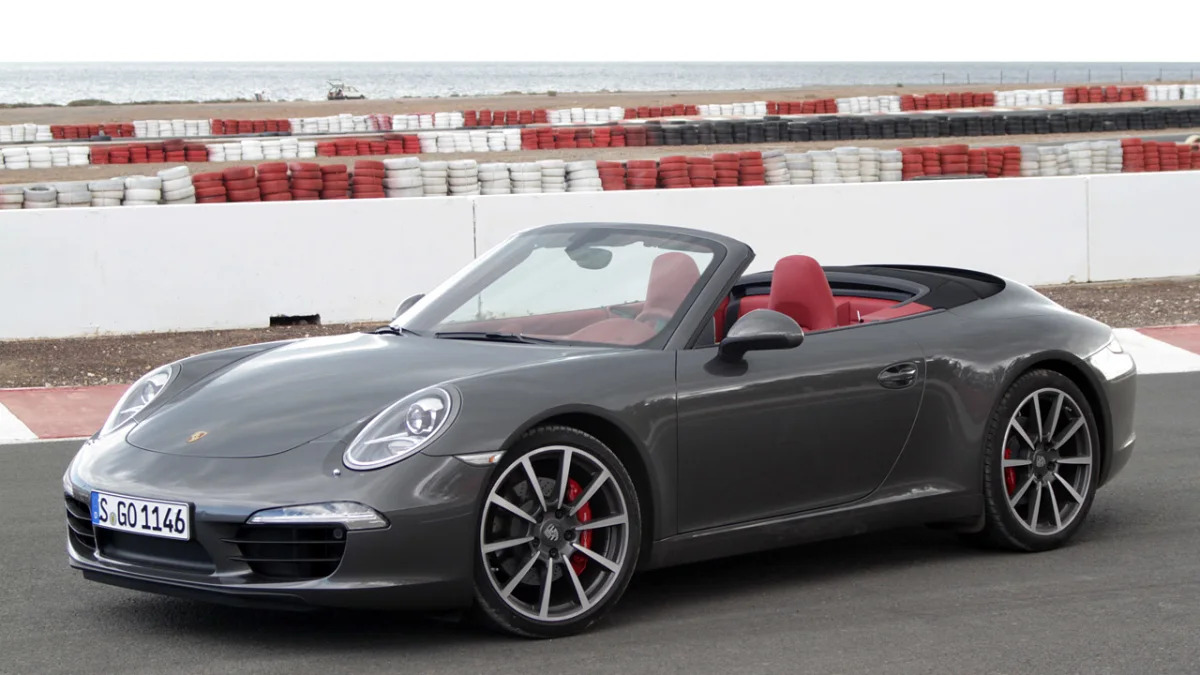









Sign in to post
Please sign in to leave a comment.
Continue